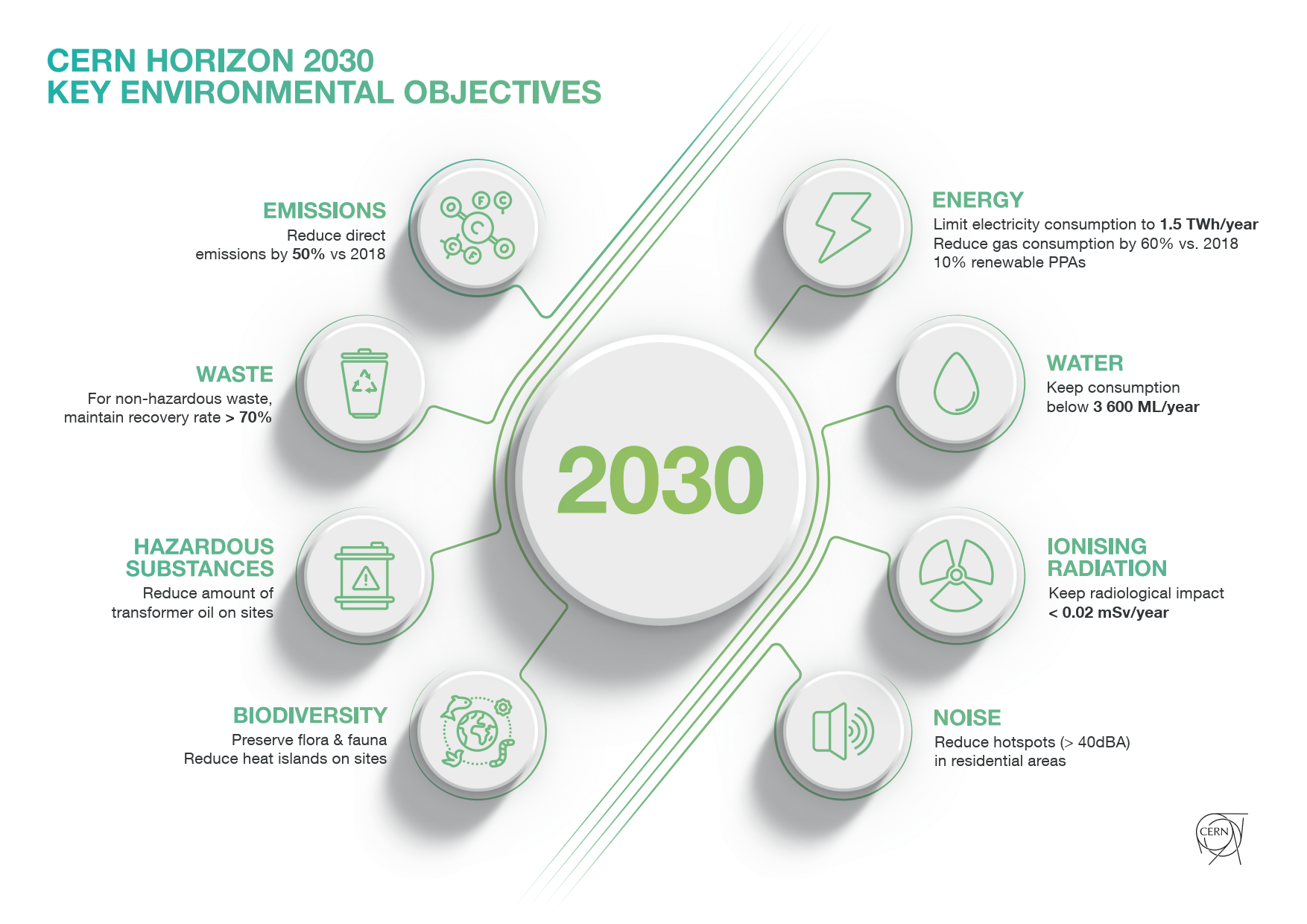
"I believe CERN should become a role model for an environmentally aware scientific laboratory."
– Fabiola Gianotti, Director-General of CERN

Over the decades, CERN has become a byword for excellence in research, establishing itself as a model for scientific collaboration across borders, technological innovation, training and education.
Today, environmental responsibility joins this list. Good environmental stewardship stands prominently among the Management’s objectives and is embedded in every corner of the Organization, with a strategic, proactive approach across the Laboratory and among CERN’s worldwide scientific community.
Contributing to the achievement of several of the environment-related UN Sustainable Development Goals (SDGs) is a natural continuum in this context, for example by improving our performance, forging partnerships with others and developing innovative solutions using CERN technologies.
CERN's environmental and sustainability strategy is founded on three primary principles: minimising the Laboratory's impact on the environment, minimising energy consumption while enhancing energy efficiency and reuse, and fostering the development of technologies that may contribute to mitigating the impact of society on the environment.
Driven by this commitment to environmentally responsible research, CERN has implemented many initiatives over the years that have helped to reduce the impact of its activities on the environment. This page provides more information on these activities across different thematic areas.
CERN is fully committed to environmental protection and transparent reporting. CERN's public environment reports set out reporting frameworks, setting and monitoring concrete goals for constant improvement.
Collaboration with the Host States
CERN works closely with its Host States in matters of environmental protection. As an organisation straddling two countries, CERN develops its own regulations, based on and in agreement with those of the Host States. Where no specific CERN regulation exists, the most relevant regulation of the two Host States is adopted.
Together with the Canton of Geneva, Switzerland, and the Prefecture of Ain, France, CERN established a tripartite committee for the environment under a memorandum of cooperation on non-radiological environmental aspects in 2007. It holds two plenary meetings per year as well as regular technical meetings.
The Laboratory signed a tripartite agreement on radiation protection and radiation safety in 2010 with the Swiss Federal Office of Public Health (OFSP) and the French Nuclear Safety Authority (ASN). This replaced previously existing bilateral agreements and created a legal framework for discussing topics related to radiation protection. The agreement provides for regular technical meetings as well as high-level plenary meetings chaired by CERN’s Director of Accelerators and Technology. In addition, the Organization formally reports to the OFSP and ASN on matters of radiation protection and, in particular, the environmental aspects thereof.
Discover CERN’s biodiversity by taking a virtual walk around the sites here.
In Brief: 2023-2024
The accelerator complex was in full operation throughout this period, following its restart in July 2022 with a view to reaching the new energy level of 13.6 TeV. Operating periods feature short shutdowns of several weeks at the end of each year for the purposes of essential maintenance. In 2024, a revised schedule for the operation and shutdown of the accelerator complex was approved, delaying the end of Run 3 and the start of the third long shutdown to mid-2026.
(2024 values shown for each domain)

1290 GWh
CERN has committed to limiting rises in electricity consumption by the end of Run 3 to 5% compared to the baseline year 2018, while delivering significantly increased performance of its facilities. This corresponds to a maximum target consumption of 1 317 GWh. It has also committed to increasing energy reuse.
CERN consumed 1 096 GWh of electricity in 2023 and 1 290 GWh in 2024. It also consumed 43 GWh (154 TJ) of energy generated by fossil fuels in both reporting years.

170 024 tCO2e
CERN’s objective is to reduce its direct emissions by 28% by the end of Run 3 compared to the baseline year 2018 (maximum target 138 300 tCO2e).
In 2023 and 2024, respectively:
– Direct Scope 1 emissions amounted to 170 482 and 170 024 tonnes of CO2 equivalent (tCO2e);
– Indirect Scope 2 greenhouse gas emissions due to CERN’s electricity consumption were 63 572 and 66 965 tCO2e;
– Indirect Scope 3 emissions arising from business travel, personnel commuting, catering, waste treatment and water purification (excluding procurement) amounted to 10 091 and 11 553 tCO2e. Those arising from procurement amounted to 100 512 and 102 730 tCO2e.

2895 ML
The Laboratory has committed to keeping the increase in its water consumption up to the end of Run 3 below 5% compared to the baseline year 2018, which corresponds to a target maximum consumption of 3 651 megalitres despite the growing demand for water cooling at the upgraded facilities.CERN used 2 830 megalitres of water in 2023 and 2 895 megalitres of water in 2024.

76% recycled
CERN’s aim is to continuously increase its recycling rate for non-hazardous waste. This rate rose from 56% in 2018 to 76% in 2024.In 2023 and 2024 respectively, CERN disposed of 3 625 tonnes and
3 419 tonnes of non-hazardous waste, and of 1 379 tonnes and 975 tonnes of hazardous waste (both conventional and radioactive).

50 hectares of areas of ecological interest
CERN’s biodiversity action plan for 2021-2025 comprises a set of initiatives designed to preserve and enhance its natural environment. These objectives are founded on Host State regulations and best practices in the field of biodiversity. The inventory of fauna and flora completed in 2022 identified some 50 hectares of areas of ecological interest, to be classed as a priority for preservation in the event of planned works and projects.

25 projects
The CERN Innovation Programme on Environmental Applications (CIPEA) was launched in 2022 as a call for ideas from the CERN community to stimulate innovation in environmental applications based on CERN’s technologies, know-how and facilities.
The programme was expanded during the reporting period to include projects defined in collaboration with external partners, mainly from industry, in the key areas identified in the 2022 strategy. The eight CERN community projects initially selected are generating the first results.

<0.01 mSv
The European annual dose limit for public exposure to artificial sources is 1 millisievert (mSv). CERN has committed to keeping its contribution to no more than 0.3 mSv per year. In 2024, the dose received by any member of the public living near the Laboratory was below 0.01 mSv.

45 dBA at night
CERN has committed to restricting the level of noise at its site perimeters to 70 dBA during the day and 60 dBA at night.
The average noise levels measured at CERN’s site perimeters are typically 50 dBA during the day and 45 dBA at night. In addition, CERN continues to monitor the evolution of noise levels in residential areas next to its sites, keeping noise footprint maps and 3D noise models up to date.

The Organization took an important step towards integrating sustainability into its procurement processes by adopting an Environmentally Responsible Procurement Policy along with an implementation strategy, both of which were approved by CERN’s Enlarged Directorate in 2023.
CERN’s materials needs are driven by the demands of cutting-edge scientific research, technology and infrastructure, which require materials of exceptional quality with unique characteristics. This report features CERN’s materials management practices for the first time.

>100 m3 mineral oil removed
CERN’s regulatory framework for hazardous substances addresses potential risks to soil and water and is continuously adapted in line with Host State regulations. These substances are subject to regular monitoring and reporting.
Continue for more information on CERN's environment reports
